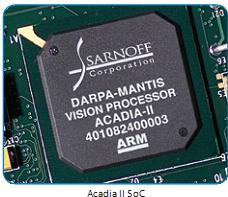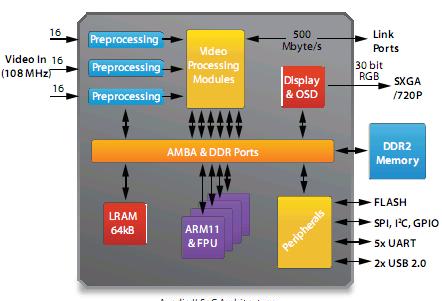Sarnoff Corporation launched Acadia II, the world’s most powerful system-on-a-chip (SoC) with real-time, portable, and low power consumption for vision processing and system control.
Acadia II performs real-time contrast enhancement, stabilization, multi-sensor fusion, and tracking. Equipped with an integrated ARM11 MPCore, Acadia II functions as a CPU for the entire system by providing users the ability to port customized processing and system interfaces. With its small form factor and low power, Acadia II is ideal for integration into portable and wearable vision systems; security and surveillance platforms; manned and unmanned aerial and ground vehicles; border and perimeter protection; and vision-aided GPS-denied navigation.
“Acadia II is the breakthrough integrated vision processing solution the industry has been waiting for,” said Mark Clifton, Sarnoff’s Acting President and Chief Executive Officer. “With much more processing power and less energy consumption in a fraction of the size, we can now take an entire system and put it within the Acadia II SoC. Acadia II will usher in a whole new generation of highly advanced end products at a fraction of the size, weight, and power of comparable systems.”
Acadia II’s next generation capabilities include:
- Three channel, pattern-selective adaptive fusion for night vision
- Real-time, low latency processing including contrast enhancement
- Full color, full resolution processing up to 720P and 1080i
- Robust stabilization and object/target tracking applications
- 1280x1024 RGB video output with on-screen display processor
- Four ARM11 300MHz floating-point processors
- 29 x 29 mm BGA package; 1.0V core, 3.3V & 1.8 V IO
- Low power design (<1W to 4W) employing four independent power-
- down regions
- Three digital video input ports supporting up to 108 MHz parallel video
- Video output port supporting up to 150 MHz parallel 30 bit RGB
- Two USB1.0/2.0 device ports (ULPI)
- Three 8-bit bidirectional general-purpose expansion ports
- UART, SPI, I2C communication ports


